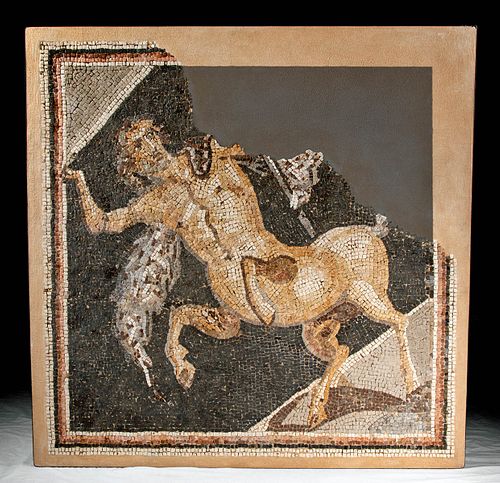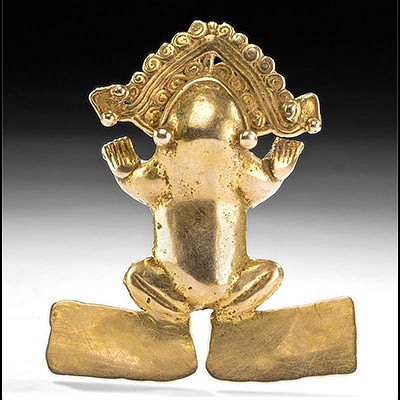Large / Impressive Roman Stone Mosaic of Centaur
Lot 36c
About Seller
Artemis Fine Arts
686 S Taylor Ave, Ste 106
Louisville, CO 80027
United States
Selling antiquities, ancient and ethnographic art online since 1993, Artemis Gallery specializes in Classical Antiquities (Egyptian, Greek, Roman, Near Eastern), Asian, Pre-Columbian, African / Tribal / Oceanographic art. Our extensive inventory includes pottery, stone, metal, wood, glass and textil...Read more
Categories
Estimate:
$24,000 - $36,000
Absentee vs Live bid
Two ways to bid:
- Leave a max absentee bid and the platform will bid on your behalf up to your maximum bid during the live auction.
- Bid live during the auction and your bids will be submitted real-time to the auctioneer.
Bid Increments
| Price | Bid Increment |
|---|---|
| $0 | $25 |
| $300 | $50 |
| $1,000 | $100 |
| $2,000 | $250 |
| $5,000 | $500 |
| $10,000 | $1,000 |
| $20,000 | $2,500 |
| $50,000 | $5,000 |
| $100,000 | $10,000 |
| $200,000 | $20,000 |
About Auction
By Artemis Fine Arts
Aug 13, 2020
Set Reminder
2020-08-13 10:00:00
2020-08-13 10:00:00
America/New_York
Bidsquare
Bidsquare : Fine Antiquities, Ethnographic & Fine Art
https://www.bidsquare.com/auctions/artemis-gallery/fine-antiquities-ethnographic-fine-art-5415
Features classical antiquities, ancient and ethnographic art from cultures encompassing the globe. Egyptian, Greek, Roman, Etruscan, Near Eastern, Asian, Pre-Columbian, Native American, African / Tribal, Oceanic, Spanish Colonial, Russian, Fine Art, so much more! Artemis Fine Arts info@artemisfinearts.com
Features classical antiquities, ancient and ethnographic art from cultures encompassing the globe. Egyptian, Greek, Roman, Etruscan, Near Eastern, Asian, Pre-Columbian, Native American, African / Tribal, Oceanic, Spanish Colonial, Russian, Fine Art, so much more! Artemis Fine Arts info@artemisfinearts.com
- Lot Description
Roman, probably the Levant, late Imperial Period, ca. 3rd to 5th century CE. A lively mosaic depicting a centaur. His head and neck are twisted back over one shoulder, his horse body rearing so that his front legs and hooves are high off the ground. The human half of the body is that of an older man, with grey hair and beard; the horse's body and the human torso are both muscular, with the artist using shading techniques to give the impression of light gleaming off strong flanks. Draped over one shoulder and flying out behind his back is a skin of some kind, possibly that of a bear, as Ovid records the centaur Aphidas wore in the "Metamorphoses". The centaur stands atop a grey floor with his shadow portrayed by darker brown/almost maroon tiles. Size of mosaic: 38" W x 38.7" H (96.5 cm x 98.3 cm); size of frame: 40.75" W x 41.75" H (103.5 cm x 106 cm)
Mosaics (opus tesellatum) are some of our enduring images from the Roman world. They reveal everyday life, social interactions, and even things like clothing styles, personal ornament, and the interior of buildings in ways other forms of Roman art generally do not, and give us an idea of what themes and decorations Romans wanted to encounter every day on the interior of their homes and public spaces. This mosaic likely would have decorated the home of a wealthy patron of the arts, and probably formed part of a floor. Centaurs seem to have been popular mosaic themes - see most notably the massive mosaic of two centaurs fighting felines from the Palace of Hadrian (ca. 2nd century CE).
In the Roman province of Syria, which encompassed most of the ancient Near East/Levant, mosaics seem to have developed as a common art form relatively late, with most finds coming from the 3rd century CE or later. Syria was one of Rome's wealthiest provinces, but it was also far removed from Rome itself and Roman culture was overlaid on enduring cultural traditions from Hellenistic Greece and the great civilizations that came before it. Antioch-on-the-Orontes (modern day Antakya, Turkey), was the capital of northern Roman Syria, and its excavations in the 1930s revealed more than three hundred mosaic pavements.
We cannot find a perfectly comparable example with this type of subject matter and size. To give you an idea of what is available, see for example this mosaic with mythological subject matter: http://www.christies.com/lotfinder/Lot/a-roman-marble-mosaic-panel-circa-3rd-5321865-details.aspx that sold for $30000 in 2010; this pair of smaller panels with less sophisticated subject matter: http://www.christies.com/lotfinder/Lot/a-late-roman-mosaic-panel-circa-4th-5th-2034792-details.aspx that sold in 2001 for roughly $6000, and this similar-sized but more colorful example: http://www.christies.com/lotfinder/Lot/a-late-roman-mosaic-panel-circa-4th-5th-5509263-details.aspx that sold for $25000 in 2011.
Provenance: ex-private Florida, USA collection, purchased in Lebanon in the 1980s
All items legal to buy/sell under U.S. Statute covering cultural patrimony Code 2600, CHAPTER 14, and are guaranteed to be as described or your money back.
A Certificate of Authenticity will accompany all winning bids.
We ship worldwide and handle all shipping in-house for your convenience.
#148763Mounted on concrete. Probably part of a larger mosaic, this panel is missing an upper portion as shown. Aside from that, the tesserae are generally in good condition with a few losses, chips, and abrasions. Light patina on surface.Condition
- Shipping Info
-
All shipping is handled in-house for your convenience. Your invoice from Artemis Gallery will include shipping calculation instructions. If in doubt, please inquire BEFORE bidding for estimated shipping costs for individual items.
-
- Buyer's Premium



 EUR
EUR CAD
CAD AUD
AUD GBP
GBP MXN
MXN HKD
HKD CNY
CNY MYR
MYR SEK
SEK SGD
SGD CHF
CHF THB
THB















